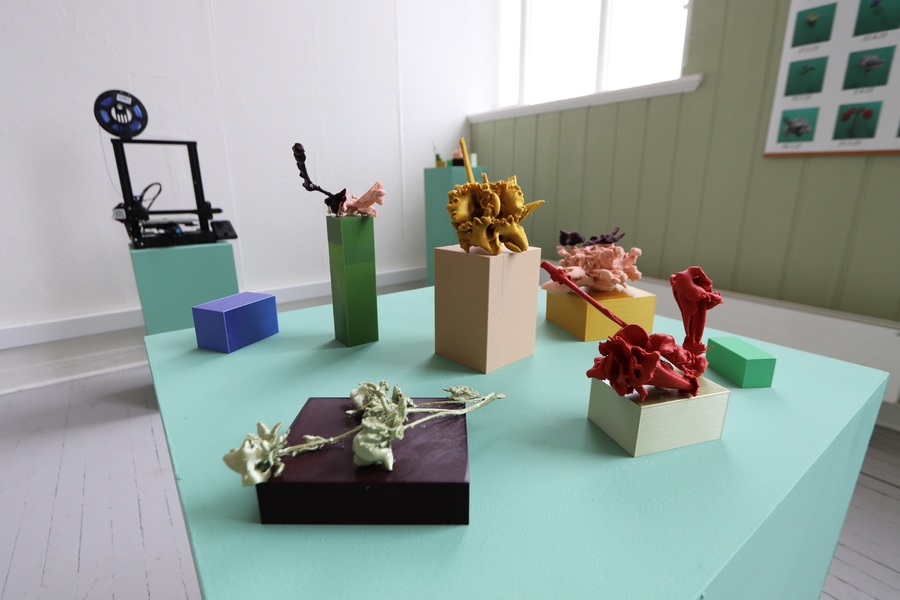Edinburgh College of Art Degree Show 2022: The review
The 2022 Edinburgh College of Art Degree Show sees the ECA graduates focus on ideas of dwelling, belonging, space and place
At Edinburgh College of Art’s 2022 degree show, there’s a palpable sense of joy that its beautiful building has come back to life and is once again filled with ambitious, energetic work. There are few direct references to COVID in the art on display, although there is a recurring interest in spaces of dwelling and belonging. On the other hand, there are also representations of inhospitable places, betraying the impact of successive lockdowns and periods of isolation on this group of students.
Rachel Glen returns to her childhood bedroom with an installation that evokes a cosy nostalgia. A gauzy purple curtain and purple tufted rug frame a painted garden scene, where a child’s birthday party is set up; for Glen, art provides an escape to simpler times. A sense of dreamlike nostalgia runs through Mia Takemoto’s beautiful painted panels. Dynamic shapes and patterns weave between fragmented family scenes, suggestive of the Roots and Routes of the work’s title and the memories that are carried along the way. Takemoto’s technique and use of materials – tempera painted on wood veneer – draw out the work’s themes of cultural hybridity, mixing influences from the artist’s Eastern and Western heritage.
Olivia-Anna Boden’s mixed media work invites the viewer into a youthful space of fantasy and fairytale, inspired by the story of the Swan Princess. Combining embroidery, painting, and found objects, Boden creates a surrealist-inspired mythology dedicated to girlhood and its transformative potential. Her use of textiles reflects a wider interest in materiality and making that is found across many of the exhibiting students’ work. Isabella Inskip’s ethereal, silky sculptures are the product of 3D printing. By transforming natural flowers into delicate technologically produced objects, Inskip raises questions about the boundaries between the natural and the artificial, the artist and the designer. Working between painting and textiles, Jessica Austin opens up liminal spaces and gothic portals to other worlds. In her polyester-stuffed textile works, tender imprints of the body foreground touch and expand the space of the canvas outwards.
In the textile department, Chloe Grieve’s Shape Play uses Bauhaus-inspired modernist forms to explore how design shapes our experiences of mental health and healthcare spaces; bold colours and lush textiles offer a less sterile, cold environment that makes hospitals and healthcare environments more hospitable, homely places.
Many of the students find less comfort in the home. Rebecca Ryan’s sculptural installation Neighbours features two adjacent metal-framed houses, linked by a patch of artificial grass. Keying into ideas of access and exclusion, only one house is open to the garden space; Neighbours plays on the false equivalence created in areas of cities, where the extremes of deprivation and luxury often sit side by side. Ryan’s use of plain fabric for the houses’ structures further emphasises a sense of instability and impermanence that defines many peoples’ relationship with home in modern society. Nearby, Lian Ryan’s green gauze maze heightens a sense of the unreality of the boundaries and structures that surround us.
Hannah Grist repurposes familiar domestic objects into strange, unhomely sculptural forms. Rusting metal radiators are bent into scarred, skeletal new shapes, or stacked to build imposing towers. A tired, grubby bathtub (complete with a tatty bar of soap) attached to four large bicycle wheels suggests an obscure instrument of torture. The title of her installation – Self-Neglect in the Comfort Zone – is a dark allusion to the self-care trend perpetuated by sanitised Instagram images, as well as the disconnect between idealised notions of home and, for many, the reality of poorly maintained, uncomfortable living spaces.
Phoebe Logan’s large vivid canvases also locate the bathroom as the focus of demands to care for and perfect the self, from a feminist perspective. Her chaotic, graffiti-style paintings show the overwhelming demands to perform femininity and the contradictory pressures to display and minimise the body that many women face. Naked figures are swept up in a swirl of confessions and declarations and sucked down the plughole. Others vomit and unashamedly display their bodies, refusing to be contained or, in Logan’s words, to be ‘dwelled upon’.
Lucy Mulholland’s wooden Cat Ladder offers a playful escape up and out of the studio, while also encouraging us to think about nonhuman experiences of everyday spaces. Similarly, Monument to Hope and Futility celebrates flies fleeing an open window, a playful symbol of the artist’s own wildness and freedom. Like many of her peers, Mulholland’s works are on a level of scale, experimentation and ambition only offered by the studio – the fact that artists and visitors alike have been welcomed back inside at last is a celebration for all.
Run ended, find out more about this year's graduates and view their work at graduateshow.eca.ed.ac.uk


